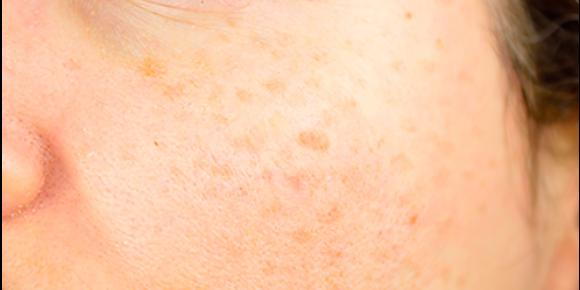
WHAT CAN GET RID OF AGE SPOTS?
If you feel that age spots are telling people you’re past your prime, you may be able to fade those spots significantly. Sometimes, you can even get rid of them.
Before you treat age spots, however, you should know a few facts. These facts can protect your health and help you to get the best results.
age spots on face
Age spots appear on areas of your body that the sun's rays often hit, such as your face and hands.
Many treatment options are available for age spots
You’ll find 2 types of treatment for age spots:
-Creams and lotions
-Procedures
Procedures, which include laser therapy and chemical peels, tend to work faster. Procedures also cost more and have a higher risk of causing side effects.
Creams and lotions, however, require discipline. To see results, you have to apply a cream or lotion once or twice a day for weeks or months.
Here’s what you should know about your treatment options.
Creams and lotions: You’ll find plenty of skin-lightening products that manufacturers claim will get rid of age spots. Many you can buy without a prescription.
Before you buy any product, it’s important to know that some contain ingredients that can be harmful to your health.
Skin lightener containing mercury can cause serious health problems
If you’d prefer to use a cream or lotion to treat age spots, the American Academy of Dermatology recommends seeing a board-certified dermatologist first.
A dermatologist can recommend a skin lightener that can effectively treat age spots without harming your health.
Seeing a dermatologist can also save you time and money. You’ll find so many skin-lightening creams and lotions available that it can be difficult to figure out which, if any, can help you.
If you need a prescription-strength skin-lightening cream, a dermatologist can choose one that meets your needs. These tend to be the more effective. In a study that compared laser treatment to a prescription-strength cream, the researchers discovered that both treatments lightened age spots significantly.
Laser treatment (procedure): One or 2 laser treatments can treat age spots quickly, and you’ll likely have longer-lasting results than with a skin-lightening cream.
Lasers can also cause some side effects, such as crusting or temporary darkening of age spots, which you won’t get with creams. These side effects tend to fade quickly.
Cryotherapy (procedure): This is a common treatment for age spots. During this procedure, a dermatologist injures the cells in the age spots by freezing them. As the skin heals, it looks lighter.
Treatment can be painful, but it’s quick. After treatment, you may have some pain, a blister, or temporary redness and swelling.
Possible permanent side effects include darkening of an age spot, lightening of the skin around the age spot, or a scar. When a board-certified dermatologist performs cryotherapy, permanent side effects are rare.
Microdermabrasion (procedure): During this procedure, a dermatologist will smooth away age spots. Studies show this can be quite effective, especially when a patient also has a chemical peel.
In one study, some patients were treated with microdermabrasion once every 2 weeks for 16 weeks. About 40% of these patients saw their age spots completely disappear. The patients who received microdermabrasion and a chemical peel had better results. Half of these patients saw their age spots completely disappear.
After a microdermabrasion treatment, you may see mild redness that will likely disappear in a few hours. In the above study, the patients also had flaky skin for 3 or 4 days.
Chemical peeling (procedure): This can effectively treat age spots on the hands. In a study that compared chemical peeling with cryotherapy, the researchers found that 47% of the patients receiving the chemical peel had a 50% lightening of the age spots. While the patients who had cryotherapy had slightly better results, the skin tends to heal faster after a chemical peel than after freezing (cryotherapy).
What looks like an age spot could be skin cancer, so you should see a board-certified dermatologist for a skin exam before treating age spots.
No matter which treatment you choose, it’s important to know that age spots can return. You can prevent this by protecting your skin from the sun.
To get the protection you need, you must apply sunscreen every day before you go outside. Not just any sunscreen will do. You need a sunscreen that offers:
Broad-spectrum protection
SPF 30 or higher
Water resistance
Covering your skin with sun-protective clothing — such as a lightweight and long-sleeved shirt, pants, a wide-brimmed hat, and sunglasses with UV protection — can also protect your skin. For more effective protection, look for clothing with an ultraviolet protection factor (UPF) label. Any skin that clothing won’t cover, however, needs sunscreen.
Dermatologists help patients find the right treatment
With so many treatment options available, it can be hard to know which to choose. A dermatologist has the expertise needed to create a treatment plan tailored to your individual needs.
A dermatologist can also tell you if a spot is actually an age spot. Other spots also become more common on our skin with age, including seborrheic keratoses and actinic keratoses.
You can find a board-certified dermatologist who can help you by going to, Find a Dermatologist. From the Specialty dropdown menu, choose Cosmetic Dermatology.
References
American Academy of Dermatology. “Choose a qualified health care provider for dermatologic procedures.” News release issued July 27, 2017.
Ortonne JP, Pandya AG, et al. “Treatment of solar lentigines.” J Am Acad Dermatol. 2006;54(5 Suppl 2):S262-71.
Schilling, LM and Nazanin S. “Commentary on a prospective trial comparing Q-switched ruby laser and a triple combination skin-lightening cream in the treatment of solar lentigines.” Dermatol Surg. 2016;42:858-9.